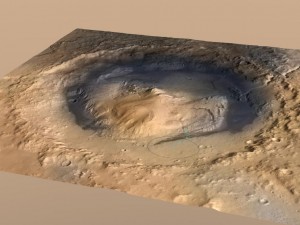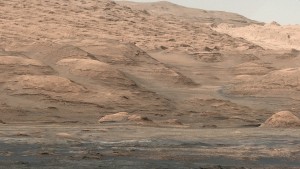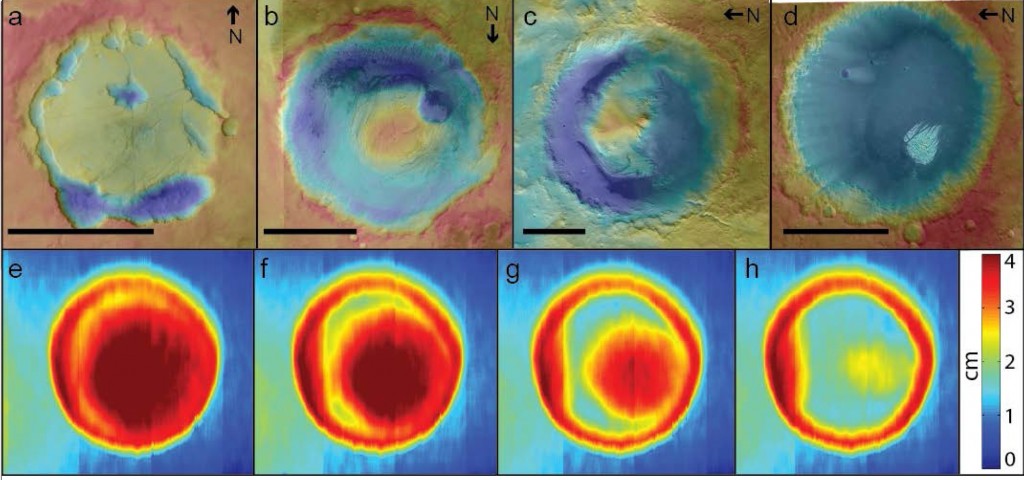31 March 2016
WASHINGTON, DC — New research has found that wind carved massive mounds of more than a mile high on Mars over billions of years. Their location helps pin down when water on the Red Planet dried up during a global climate change event.

Gale Crater, the landing spot of NASA’s Curiosity Mars rover, has a three-mile-high mound at its center called Mount Sharp. The circle indicates the rover’s landing place. The blue line is its path. New research shows mounds like this may have been carved by wind over billions of years.
Credit: NASA/JPL.
The new study was published today in Geophysical Research Letters, a journal of the American Geophysical Union.
The findings show the importance of wind in shaping the Martian landscape, a force that, on Earth, is overpowered by other processes, said Mackenzie Day, a graduate student at the University of Texas at Austin Jackson School of Geosciences and lead author of the study.
“On Mars there are no plate tectonics, and there’s no liquid water, so you don’t have anything to overprint that signature and over billions of years you get these mounds, which speaks to how much geomorphic change you can really instigate with just wind,” Day said. “Wind could never do this on Earth because water acts so much faster, and tectonics act so much faster.”
Day conducted the research with Jackson School researchers Gary Kocurek and David Mohrig of the Department of Geological Sciences and University of Texas at Dallas researcher William Anderson.

The lower flank of Mount Sharp, a sedimentary mound inside Gale Crater on Mars.
Credit: NASA/JPL-Caltech/MSSS.
First spotted during NASA’s Viking program in the 1970s, the mounds are at the bottom of craters. Recent analysis by the Mars rover Curiosity of Mount Sharp, a mound over three miles high inside Gale Crater, has revealed that the thickest ones are made of sedimentary rock, with bottoms made of sediments carried by water that used to flow into the crater and tops made of sediments deposited by wind. However, how the mounds formed inside craters that were once full of sediments was an open question.
“There’s been a theory out there that these mounds formed from billions of years of wind erosion, but no one had ever tested that before,” Day said. “So the cool thing about our paper is we figured out the dynamics of how wind could actually do that.”
To test whether wind could create a mound, the researchers built a miniature crater 30 centimeters wide and 4 centimeters deep, filled it with damp sand, and placed it in a wind tunnel. They tracked the elevation and the distribution of sand in the crater until all of it had blown away. The model’s sediment was eroded into forms similar to those observed in Martian craters, forming a crescent-shaped moat that deepened and widened around the edges of the crater. Eventually all that was left of the sediment was a mound — which, in time, also eroded away.
“We went from a filled crater layer cake to this mounded shape that we see today,” Day said.

Sediment-filled craters on Mars (top) in different stages of erosion compared with results of a crater model in wind-tunnel experiment (bottom). Warm colors indicate high elevation, cool colors low elevation. Credit: Mackenzie Day.
To understand the wind dynamics, researchers also built a computer model that simulated how the wind flowed through the crater at different stages of erosion.
The mounds’ structure helps link their formation to climate change on Mars, Kocurek said, with the bottom being built during a wet time, and the top built and mound shaped in a dry time.
“This sequence signals the change from a dominance of depositional processes by water during a wetter time, to wind reworking of these water-laid sediments with the onset of aridity, followed by wind erosion once these sediment supplies have been exhausted,” he said. “Overall, we are seeing the complete remaking of the sedimentary cycle on Mars to the one that characterizes the planet today.”
The research helped scientists home in on Mars’ Noachian period, a geologic era that began about 3.7 billion years ago, as the period when Mars started to change from a wet world to a dry one. Scientists were able to link the climate change to the Noachian by studying the location of more than 30 mounds and finding that sedimentary mounds were only present on terrain that was exposed during that period.
###
The American Geophysical Union is dedicated to advancing the Earth and space sciences for the benefit of humanity through its scholarly publications, conferences, and outreach programs. AGU is a not-for-profit, professional, scientific organization representing more than 60,000 members in 139 countries. Join the conversation on Facebook, Twitter, YouTube, and our other social media channels.
Notes for Journalists
This research article will be open access for 30 days from the date of publication. A PDF copy of the article can be downloaded at the following link: http://onlinelibrary.wiley.com/doi/10.1002/2016GL068011/pdf
After 30 days, journalists and public information officers (PIOs) of educational and scientific institutions who have registered with AGU can download a PDF copy of the article from the same link.
Journalists and PIOs who have not registered with AGU may order a copy of the final paper by emailing a request to Lauren Lipuma at [email protected].
Please provide your name, the name of your publication, and your phone number.
Neither the paper nor this press release is under embargo.
“Carving intra-crater layered deposits with wind on Mars”
Authors:
Mackenzie Day, Gary Kocurek, David Mohrig: Department of Geological Sciences, Jackson School of Geosciences, University of Texas at Austin, Austin, Texas, U.S.A.;
William Anderson: Department of Mechanical Engineering, University of Texas at Dallas, Dallas, Texas, U.S.A.
Contact Information for the Authors:
Mackenzie Day: [email protected], + 1 (425) 941-7938
Lauren Lipuma
+1 (202) 777-7396
[email protected]
University of Texas at Austin Contact:
Monica Kortsha
+1 (512) 471 2241
[email protected]